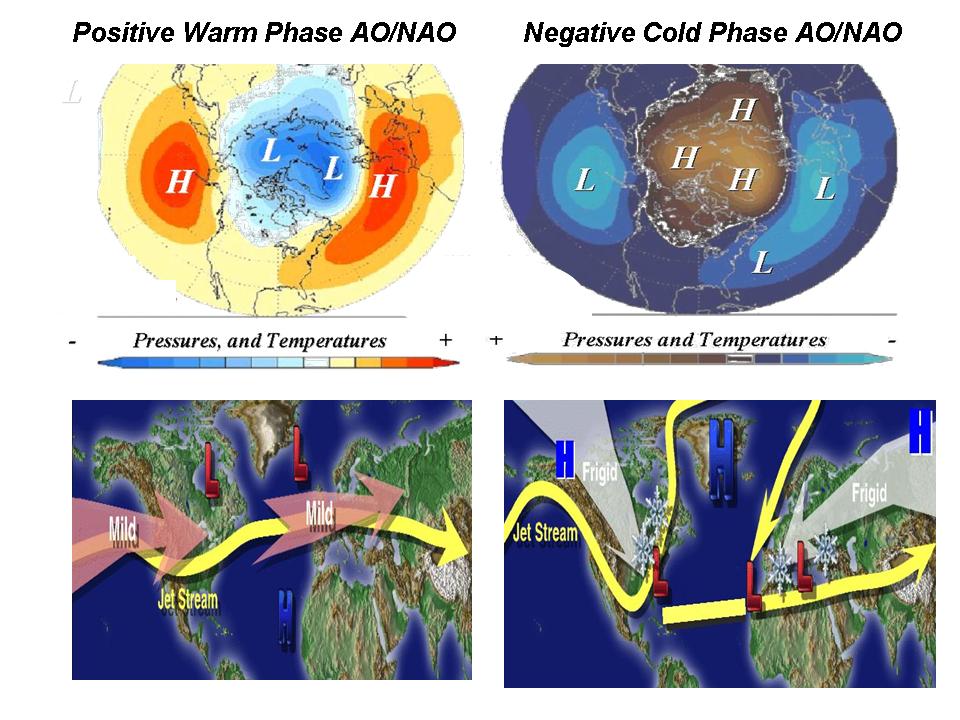In the April 3rd edition of Science a collaborative group of scientists from Switzerland, California and the UK report that medieval climate over Europe was heated by the North Atlantic Oscillation (NAO). This oscillation pattern, defined as the pressure difference between the Icelandic Low and the Azores High, also influences modern-day weather conditions and has contributed to the recent droughts in North Africa and floods in North-Central Europe.
Critique of PhysOrg article.
A comparison of tree rings from 1000-year old trees in Morocco and growth layers in a stalagmite from a cave in Scotland now reveal the mechanism behind the 'Medieval climate anomaly' - a period of global warmth between 1000 and 1400 AD. During this period, the pressure difference between the Azores High and the Icelandic Low was large and, by driving warm Atlantic winds over the cold European continent in winter time, was heating the European mainland.
Trees and stalagmites are "proxy archives", meaning that they are natural data sources from which past climatic conditions can be derived. Old cedar trees from the Atlas Mountains in Morocco grew extremely slowly during Medieval Times and thus reflect much drier conditions during this period compared to following centuries. These dry conditions, in turn, are an indicator for a strong Azores High. Opposite to the African tree rings, the Scottish stalagmite shows that during the same period it was much wetter than normal in northern Europe, reflecting a strong Icelandic Low.
Comment: Take notice of the use of the language here. Specifically this article's minimization of the Medieval Warm Period is now the 'Medieval climate anomaly'.
Scientists from the Dendro Sciences Unit at the Swiss Federal Research Institute have teamed up with experts from the USA and the UK, including Royal Society-Leverhulme Trust Senior Research Fellow Professor James Scourse of the School of Ocean Sciences at Bangor University, to compile and to develop the first NAO reconstruction to extend back to the Middle Ages. By comparing these proxy archives to modelled climate simulations they were able to analyse temperature, precipitation, and wind conditions across Europe over the last millennium and to test the reliability of their results. Comparisons with other terrestrial and marine proxy archives from across the globe suggest that the changes seen in the NAO are part of a global reorganization of the ocean-atmosphere system.
Valerie Trouet, first author of this study, points out that "the modern-day effects of the NAO are relatively small and short-lived compared to those during the Middle Ages". This study demonstrates that climate has undergone large changes long before humans started releasing large amounts of greenhouse gases into the atmosphere, indicating that natural forcings should be taken into account when trying to understand the climate of the future.
See Climate Audit's issues with the study and the conclusions of Mann etal that it confirms the Medieval Warm Period as a regional phenomenon focused on Europe. CO2 Science has shown the MWP to be truely global in nature supported by data published by 690 individual scientists from 404 separate research institutions in 40 different countries here.




Comment: The attention focused on this article is because of the work and intent of the authors' of the paper discussed. The paper basically reduces the Medieval Warm Period to a regional European phenomenon using the old bag of tricks employed by Michael Mann of the infamous hockey-stick graphic (used to eliminate the Medieval warm period and show man-made global warming).
The discussion is rather in depth but it does show how low the man made global warming proponents will go to validate their beliefs.
Climate Audit's discussion has become quite expansive with several articles demonstrating the deceptiveness of the methods used in the paper.
Discussions can be reviewed here:
(Link) (Link) (Link) (Link) (Link) (Link) (Link) (Link)
Additionally the Medieval Warm Period was a world wide climatic event. As IceCap pointed out CO2 Science has setup a database to track research on the medieval Warm period. (Interactive map here java plugin)
The database preface reads: